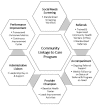From Policy Statement to Practice: Integrating Social Needs Screening and Referral Assistance With Community Health Workers in an Urban Academic Health Center
- PMID: 31894711
- PMCID: PMC6940600
- DOI: 10.1177/2150132719899207
From Policy Statement to Practice: Integrating Social Needs Screening and Referral Assistance With Community Health Workers in an Urban Academic Health Center
Abstract
Purpose: Social and economic factors have been shown to affect health outcomes. In particular, social determinants of health (SDH) are linked to poor health outcomes in children. Research and some professional academies support routine social needs screening during primary care visits. Translating this recommendation into practice remains challenging due to the resources required and dearth of evidence-based research to guide health center level implementation. We describe our experience implementing a novel social needs screening program at an academic pediatric clinic. Methods: The Community Linkage to Care (CLC) pilot program integrates social needs screening and referral support using community health workers (CHWs) as part of routine primary care visits. Our multidisciplinary team performed process mapping, developed workflows, and led ongoing performance improvement activities. We established key elements of the CLC program through an iterative process We conducted social needs screens at 65% of eligible well-child visits from May 2017 to April 2018; 19.7% of screens had one or more positive responses. Childcare (48.8%), housing quality and/or availability (39.9%), and food insecurity (22.8%) were the most frequently reported needs. On average, 76% of providers had their patients screened on more than half of eligible well-child visits. Discussion: Our experience suggests that screening for social needs at well-child visits is feasible as part of routine primary care. We attribute progress to leveraging resources, obtaining provider buy-in, and defining program components to sustain activities.
Keywords: community health workers; implementation; improvement; pediatrics; quality; social determinants of health.
Conflict of interest statement
Figures




Similar articles
-
Integrating Social Needs Screening and Community Health Workers in Primary Care: The Community Linkage to Care Program.Clin Pediatr (Phila). 2020 Jun;59(6):547-556. doi: 10.1177/0009922820908589. Epub 2020 Mar 5. Clin Pediatr (Phila). 2020. PMID: 32131620 Free PMC article.
-
Basic social resource needs screening in the gynecologic oncology clinic: a quality improvement initiative.Am J Obstet Gynecol. 2020 Nov;223(5):735.e1-735.e14. doi: 10.1016/j.ajog.2020.05.028. Epub 2020 May 17. Am J Obstet Gynecol. 2020. PMID: 32433998 Free PMC article.
-
Addressing social determinants of health at well child care visits: a cluster RCT.Pediatrics. 2015 Feb;135(2):e296-304. doi: 10.1542/peds.2014-2888. Epub 2015 Jan 5. Pediatrics. 2015. PMID: 25560448 Free PMC article. Clinical Trial.
-
Screening for Social Determinants of Health at Well-Child Appointments: A Quality Improvement Project.Nurs Clin North Am. 2019 Mar;54(1):141-148. doi: 10.1016/j.cnur.2018.10.009. Epub 2018 Dec 17. Nurs Clin North Am. 2019. PMID: 30712540 Review.
-
Health-Related Social Needs Screening and Referral in Pediatric Primary Care: A Systematic Review.J Pediatr Health Care. 2024 Nov-Dec;38(6):850-865. doi: 10.1016/j.pedhc.2024.05.012. Epub 2024 Jul 17. J Pediatr Health Care. 2024. PMID: 39023460
Cited by
-
Interventions addressing health-related social needs among patients with cancer.J Natl Cancer Inst. 2024 Apr 5;116(4):497-505. doi: 10.1093/jnci/djad269. J Natl Cancer Inst. 2024. PMID: 38175791 Free PMC article.
-
Primary care-based interventions to address the financial needs of patients experiencing poverty: a scoping review of the literature.Int J Equity Health. 2021 Oct 7;20(1):219. doi: 10.1186/s12939-021-01546-8. Int J Equity Health. 2021. PMID: 34620188 Free PMC article.
-
Association between Unmet Social Need and Ambulatory Quality of Care for US Children.Acad Pediatr. 2025 Mar;25(2):102589. doi: 10.1016/j.acap.2024.10.001. Epub 2024 Oct 17. Acad Pediatr. 2025. PMID: 39424186
-
Social determinants of health in pulmonary arterial hypertension patients in the United States: Clinician perspective and health policy implications.Pulm Circ. 2022 Jul 1;12(3):e12111. doi: 10.1002/pul2.12111. eCollection 2022 Jul. Pulm Circ. 2022. PMID: 35874851 Free PMC article.
-
Social Determinants of Health Screening by Preclinical Medical Students During the COVID-19 Pandemic: Service-Based Learning Case Study.JMIR Med Educ. 2022 Jan 17;8(1):e32818. doi: 10.2196/32818. JMIR Med Educ. 2022. PMID: 35037885 Free PMC article.
References
-
- Denavas-Walt C, Proctor BD. Income and poverty in the United States: 2014. Current population reports; https://www.census.gov/content/dam/Census/library/publications/2015/demo.... Published September 2015. Accessed August 10, 2018.
-
- World Health Organization. A conceptual framework for action on the social determinants of health. Social Determinants of Health Discussion Paper 2; http://www.who.int/sdhconference/resources/Conceptualframeworkforactiono.... Published 2010. Accessed June 29, 2018.
Publication types
MeSH terms
Grants and funding
LinkOut - more resources
Full Text Sources
Medical
Miscellaneous

